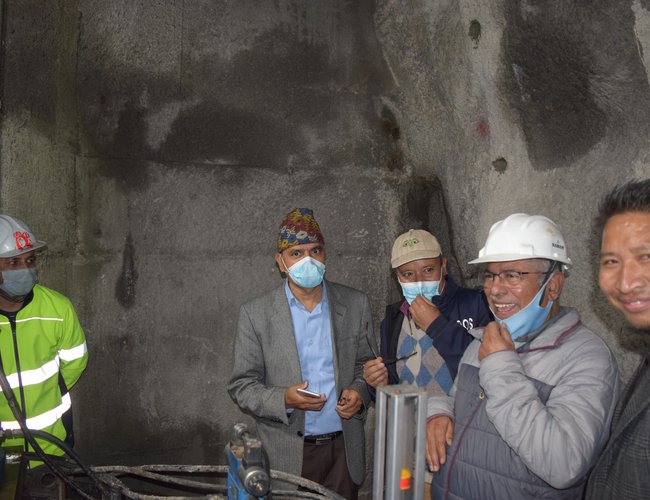
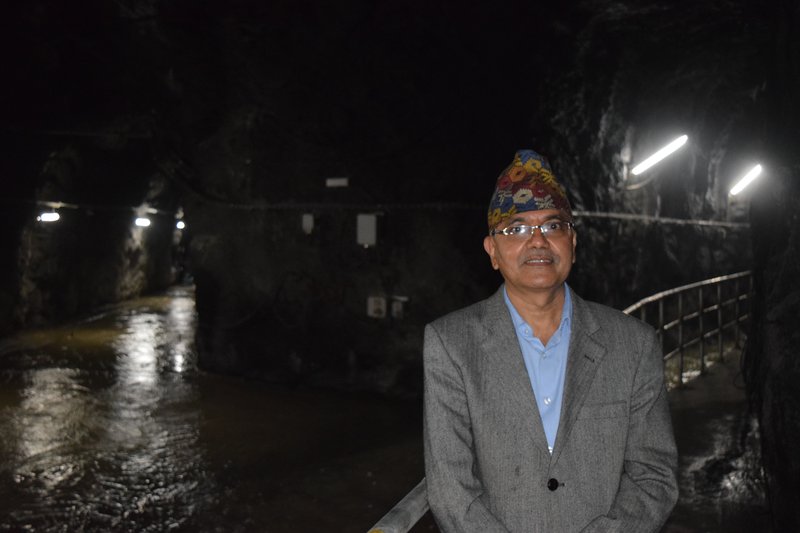
After jointly switching on the headworks at Ambathan, 60 kilometers Northeast of Kathmandu, Minister for Water Supply Mani Chandra Thapa, Minister for Youth and Sports Dawa Lama and State Minister for Urban Development Ram Bir Manandhar, finally diverted a portion of the water flowing towards the Indrawati river to a 27.5-kilometer tunnel heading to Kathmandu on 22 February. It will take almost 15 days to fill the tunnel for test.
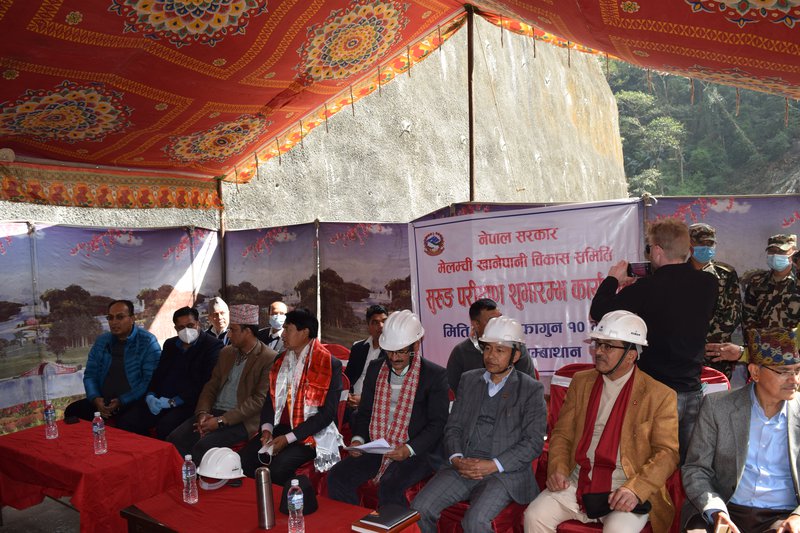
For Secretary of Ministry of Water Supply Madhav Belbase, who was watching the events quietly with his colleagues of the project, technicians, contractors, local leaders and the local community, diverting water for testing was a matter of great satisfaction, as Bhagirath effort.
Unlike in the first failed testing, the project also chose an auspicious day of the local Hyalmu community to divert the water. With the advice from the local religious gurus, February 22, the tenth day (Dashami) of Loshar, was chosen as a highly auspicious day of Padamsambhaba to divert the water.
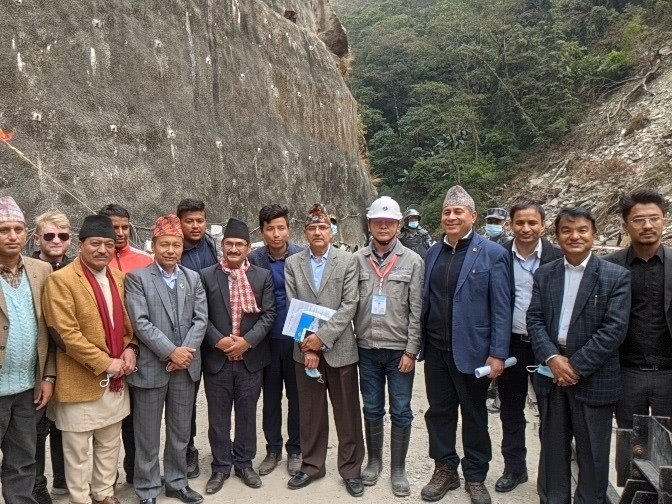
Along with worshiping the local Hindu deities, Buddhist Monks from nearby Monasteries also chanted the hymns and worshiped Guru Padmsambhaba and other Buddha.
At the function organized cautiously after learning a lesson from the devastating incident of July 14, the Ministry of Water Supply and Melamchi Drinking Water Development Board took every precautionary measure to prevent any disaster. Thus, the tunnel was made to fill up at the pace of 250-liter per-second. With the installation of Skoda smart systems, the technicians can see any faults and obstructions in the tunnel.
For testing purposes, Sino-hydro released water into the tunnel via a temporary pipeline and the temporary dam erected on the Melamchi River on July 5, 2020.
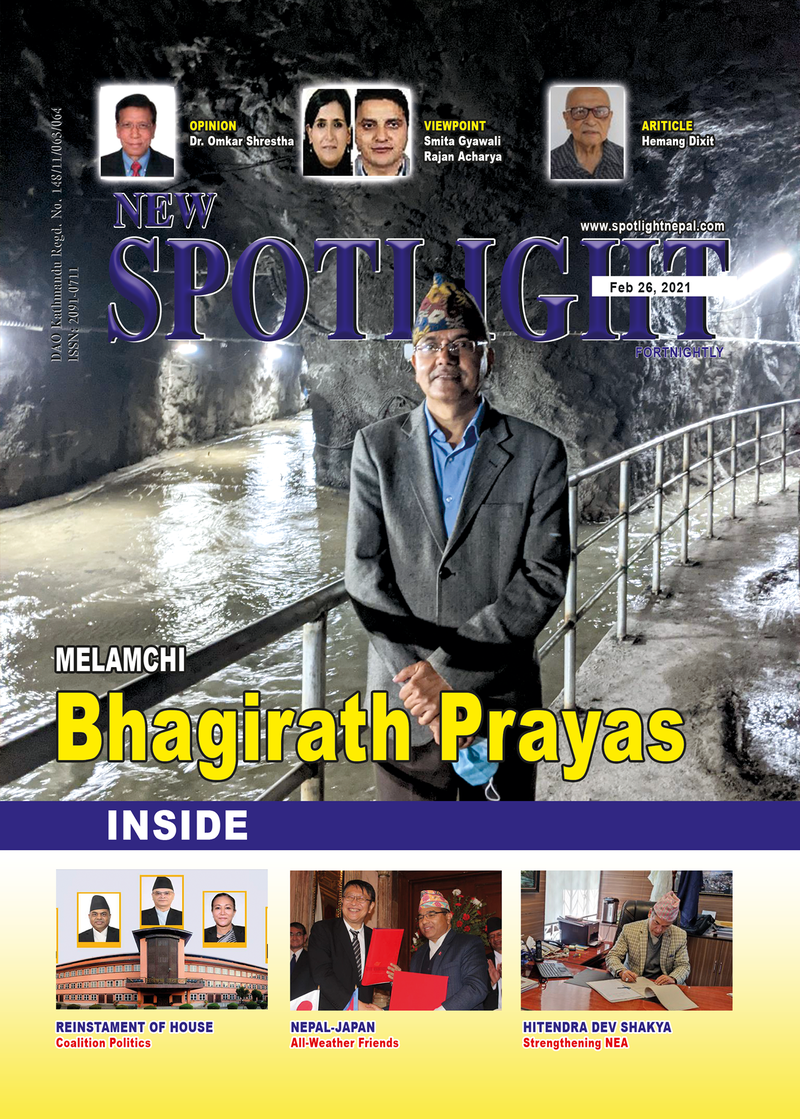
Nine days after the release of water on July 14, 2020, gate 17 at the end of the Ambathan adit failed, bursting open and allowing water in the tunnel to flood out in a torrent sweeping away two, an engineer and driver of the project, with the vehicle on July 14. Two others were left injured.
Recognizing the sacrifice made by the two staff, secretary Belbase called for one minute of silence to pay respect to those who died. “Although we cannot bring back the human loss on the incident, it has taught us a great lesson. We are taking all possible technical precautions this time,” said secretary Belbase.
Belbase in the ministry
Transferred at the Ministry in November 2019, taking charge from Deependra Nath Sharma, who retired after completing the process of selection of new contractors, Balbase had to clear the hurdle and mess created in the December 2018 incident and conciliation of the contract agreement.
Cooperativa Muratori e Cementisti (CMC) di Ravenna an Italian Contractor, which had completed one of the most difficult parts of the project, was kicked out from the project in humiliation by the decision of then minister Bina Magar and secretary Gajendra Thakur.
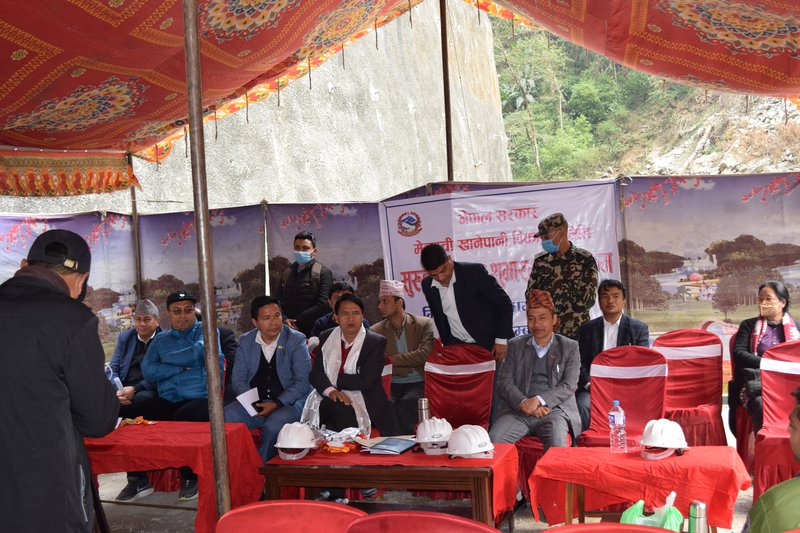
Almost at the stage of completion, the termination of the contract agreement by the government with CMC put this pride project of Nepal in uncertainty.
With his skills and working capacity, secretary Belbase, who took the baton from his colleague Sharma, put the project into a current stage with almost 95 percent of construction work of overhead already completed by Chinese Contractor Syno Hydro.

With so many dramas, turmoil and change in political leadership, Melamchi now enters into a testing stage and is likely to come up with water to fill in the empty buckets of thirsty residents of Kathmandu Valley.Melamchi Video
“This is a great day for all Nepalis not only for the residents of Kathmandu-Valley and people in Melamchi. Completion of this project will boost the morale of the Nepalis living all over Nepal,” said Minister Thapa, who expressed his full commitment to fulfill all the rightful demands of the concerned stakeholders.
Addressing the function, with local leaders, minister Thapa expressed that this is the happiest day in his life that the completion of the project conceived by saint leader Krishna Prasad Bhattarai happened during the tenure of Prime Minister K.P. Sharma Oli. “The project is now linked with the prestige of the country. Failure of this project at this juncture means the failure of Nepal.”
First conceived in Nepal Government’s policies and programs of 1988 and addressed by late King Birendra as an alternative drinking water project for Kathmandu Valley, the project found Krishna Prasad Bhattarai, the first democratic prime minister following the restoration of multi-party democracy in 1990, as its champion pledging citizens of Kathmandu Valley that he would divert the water from Melamchi that would be enough to clean the roads and streets of Valley.
With PM Bhattarai losing the elections in 1991, the pace of Melamchi slowed. The project was revived during Bhattarai’s second tenure in 1998. During his 11 months tenure, the project made a breakthrough with Asian Development Bank agreeing to lead the consortium.
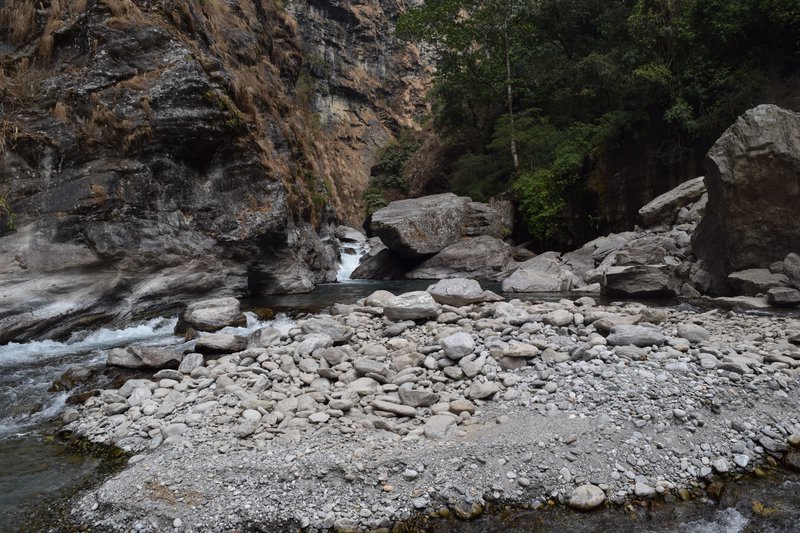
From Krishna Prasad Bhattarai to present prime minister K.P. Sharma Oli, the project has faced many hurdles. For the sake of political compromise in 2018, Prime Minister Oli also did not take any action against Minister Bina Magar and secretary Gajendra Thakur for their blunders.
Bhagirath Legacy
Hindus believe that water is life and it is also a part of religion and culture. Water is sacred and pure. They believe that water was brought down to earth from heaven with a long sacrifice and effort of Bhagirath.
To pay respect to Bhagirath, there is a tradition and practice to erect the statue of Bhagirath beneath stone spouts. People who visit the stone spout for water donate the first part of water to Bhagirath.
According to this long legend, Bhagirath spent ten thousand years of hard and difficult efforts to woo Ganga (Mother of water) to come down to earth from heaven and to salvage his ancestors who died due to the curse of Saint Kapilmuni. Impressed by the hard efforts and dedication of Bhagirath, Ganga came to earth from heaven.
It was not ten thousand years this time, but it took over 3 decades or two generations to see the water finally being diverted from Melamchi to Kathmandu Valley. “I do think that Melamchi is heaven for over 5 million population of Kathmandu Valley as they will get the water from here. It is like Bhagirath prayas to get the water,” said Ram Bir Manandhar, minister of the state of urban development and elected leader of Kathmandu valley to House of Representative. “I feel Ganga is coming to us from Melamchi.”
Bhagirath’s wish was simple and unselfish. He wanted to provide pure water to salvage his ancestors and salvage people. Religiously, it was justifiable for 100 years.
However, the case with Melamchi is different. Melamchi project was delayed because of mismanagement and lure of money of people and incompetence at policy levels.
Whatever the reason, Melamchi did not find anyone like Bhagiraath. Had someone made Prayas or Effort like Bhagirath’s, it would have completed a long time back.
Bringing the Ganges to this earth was one of the most difficult tasks for humans. King Bhagirath made some extreme efforts to “persuade” Ganges to come to this earth from the heavens.
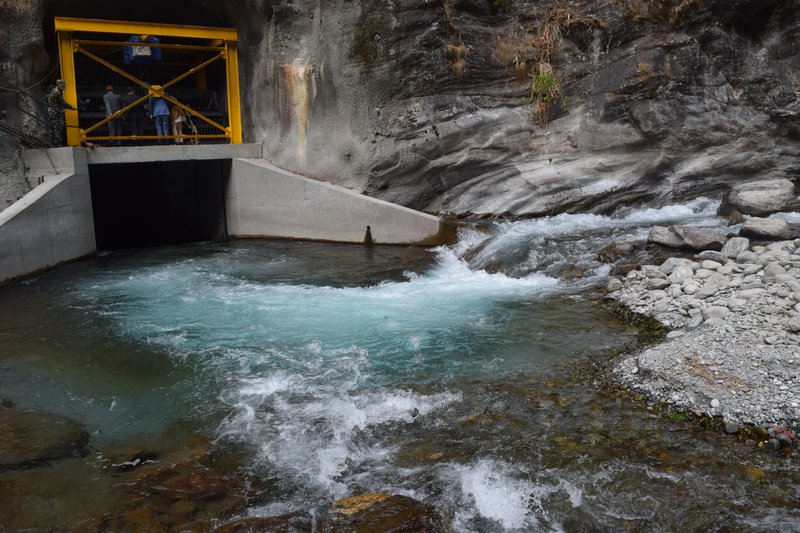
It’s been said that he meditated for 1000 years to finally persuade the great river to descend to Earth. Such was his obligation that the original name of Ganges, from Gangotri (it’s the source), is known as “Bhagirathi” ie. “Of Bhagirathi”. So, whenever someone makes prolonged or extraordinary efforts, those efforts are known as “Bhagirath Prayaas”
Bhagīratha is a legendary king of the Ikshvaku dynasty who brings the Sacred River Ganges, personified as the Hindu River Goddess Ganga, to Earth, from the Heavens.
It is said that after Bhagiratha became prince of Sagara Dynasty, learning the awful end of his forefathers, who were unable to attain the region of gods, he regretfully made over his kingly duties to his minister and went to practice austerities in the Himalayas.
On the advice of his guru Trithala, he did penance for a thousand years (according to god timeline) to please Ganga, to gain the release of his 60,000 great-uncles from the curse of saint Kapila.
Melamchi’s Effort
Following the diverting of water from Melamchi River to 27.5-kilometer long tunnel, over three decades of planning and work to bring the water to Kathmandu is coming closer.
“If things go technically well, people of Kathmandu Valley will receive the water within two months,” said Executive Director Melamchi Drinking Water Board addressing the program. “We are ready to address all the grievances of local people. Following the release of water, we will begin the most challenging task of testing then commissioning of the project.”
Although the Melamchi river has provided immense economic benefits to the local people with access to road, livelihood scheme, a guarantee of 30 percent of water to release downstream and levy to the affected Rural Municipality, there are still voices of concern.
“We are proud to share our Melamchi with the residents of Kathmandu Valley. However, local residents of the affected region also need to be compensated well and their concerns need to be addressed,” said Sher Bahadur Tamang, a former member of the House of Representatives.
The testing was conducted to divert water in the tunnel from Melamchi River to Sundarijal of Kathmandu. The water from the Melamchi River would reach Kathmandu after the testing of the tunnel is completed in three phases by diverting the water. It will take at least two months to complete the test.
The project aims to supply 170 million liters of freshwater/day to the capital city. Drill blast excavation of the 27.5 km long tunnel had progressed, in addition to works at the portals, from 18.4 m 2 intermediate adits, the main ones at Ambathan, Gyalthum and Sindhu.
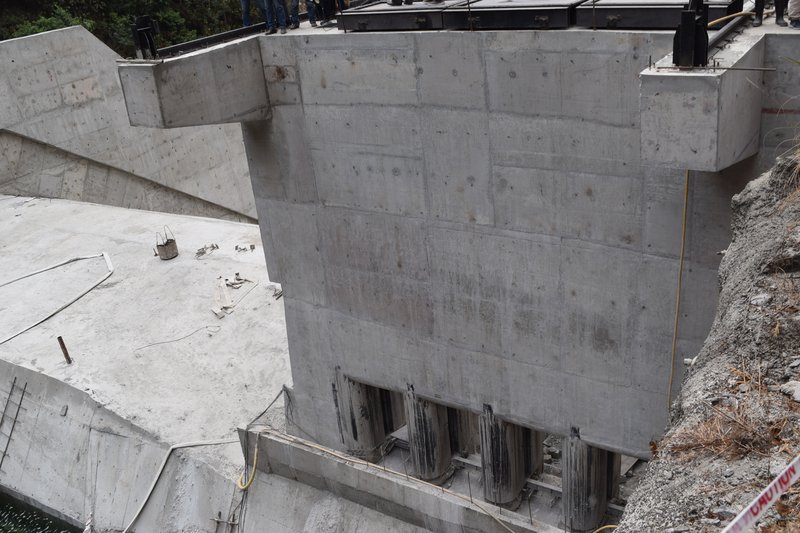
The project has decided to water-up a tunnel from the Melamchi River to test its hydraulics and operating mechanical equipment. The aim was to complete the long-awaited and urgently needed project by the end of the year.
There are a total of 29 control gates for the operation of the water supply tunnel including five 12.5m 2 adit bulkhead gates with a radial gate at the intake and a control gate at the downstream end.
The gates for the project are designed, supplied and imported to Nepal and installed by a company from India. The project contractor, Sinohydro of China, completed the civil works associated with the installation of the gates including the rock support around the doors and the shotcrete support of the adit junction with the main tunnel. All the adit gates were closed ahead of the watering-up test.
Gate 17 is at the end of the first adit from the upstream end of the waterway. The adit is about 800m from the intake portal of about 300m long. The waterway tunnel has a gentle gradient with a head of about 13m over the 27.5km of the tunnel. The tunnel is designed to run full and under pressure to operate the outlet pipe in the tunnel crown at the downstream end.
For the test, the tunnel was being filled at a rate of about 0.26 liters/sec, or about 20% of the designed inflow at the intake during inaugurated operation. At this rate, it would have taken an expected 15 to 20 days to fill.
According to tunnel testing protocol, it will take 15 days to fill the tunnel or the tunnel will be filled with water by the 14 of March. As per the protocol, water needs to be stored for 10 days inside the tunnel. Similarly, it will take another 17 days to empty the tunnel and 7 days will be spared to inspect the tunnel. Then another 17 days will be for filling the water for the distribution to Kathmandu. The testing and trial period will take 51 days. It means water will arrive in Kathmandu for distribution on the second week of April.
Although it will take a certain time to start the distribution of water all over the valley, a few lucky customers having old connections will receive the water of Melamchi from the second week of September.
Started on 21 December 2000, the Melamchi Water Supply Project is assisted by the Asian Development Bank to bring 170 million liters of water per day to Kathmandu. The construction work of the project started in 2008.
However, the second phase of construction of the tunnel to Yangri and Larke to bring an additional 340 million liters is still in the planning phase. Although the water is diverted by constructing a temporary cofferdam, the construction of permanent structures including diversion weir, river-training structures, and sediment exclusion basins is at the final stages.
In 2000 AD, a loan agreement was signed between the government and the Asian Development Bank for the completion of the project by 2007. As the work could not move ahead as expected, the project was restructured in 2008 AD.

As the Italian contractor left in December 2018, the work halted till October 2019 before the government awarding the contract again to a Chinese company. With the surge of coronavirus in 2020 and 80 days of lockdown from March 24, the pace of work slowed down. From the initial period of late Dinesh Chandra Pyakurel as a project chief, Melamchi Water Supply Board got 14 directors in the last two decades. All of them have contributed to carrying out the project.
Having worked for a long time on the project, Executive Director Tiresh Khatri is able to push the project even at lockdown. As water is now in the process of filling the tunnel, minister Thapa, secretary Belbase, executive director Khatri, technical staff, consultants, contractors and local residents stood together with enthusiasm, Bhagirath Prayas will bring the fruit only after the water transfer happens in the basin of Bagmati. Four months away from his retirement, completing Melamchi will be a jewel in the career of secretary Belbase.
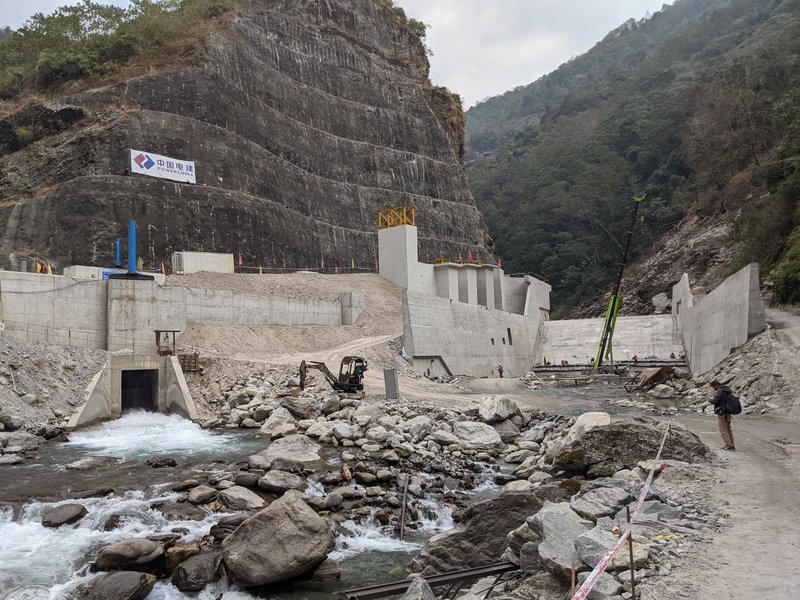
Timeline
1970 -A committee to address the water crisis in Kathmandu Valley formed
1988- British Company identifies Melamchi River as a top priority
1997 - Formation of Melamchi Water Limited
1998 -Feasibility study, DPR and formation of Melamchi Water Supply Development Committee
2000 - Loan agreement of Rs 120 million signed with ADB with a completion target of 2007
2008-Project restructured
2009 - Contract agreement with China Railway 15 Bureau for tunnel work
2012- Chinese company announces unilateral contract termination, government scraps contract subsequently
2013- Italian contractor CMC appointed for remaining tunnel work
2016 - New deadline of June 2018 set
2019, Nepal Government terminated the agreement with CMC
2019 October Contract Agreement with Syno-hydro signed to complete the remaining work including headwork
2020 July Tunnel bursts during the testing
2021 September Experts team inspects and examines tunnel
2021 February 22, Testing begins again
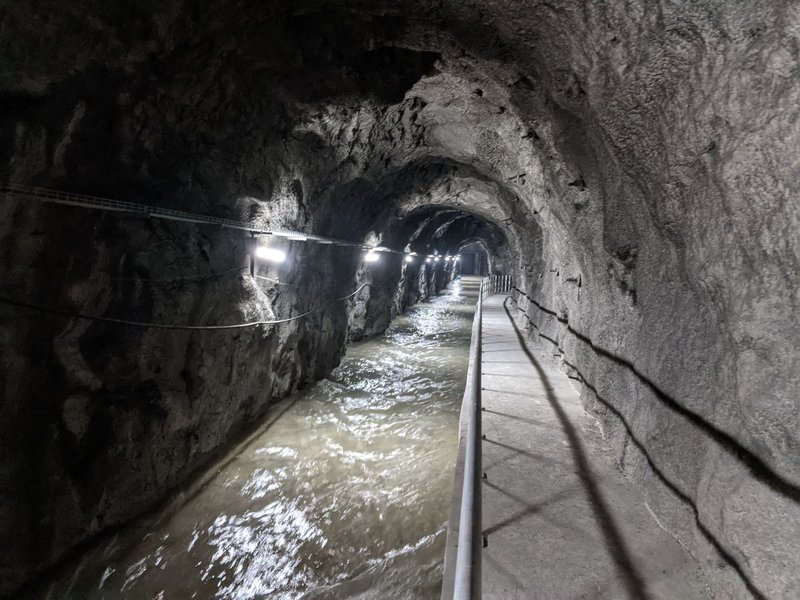

Keshab Poudel
Poudel is the editor of New Spotlight Magazine.
- ETFC Nepal is focused on expanding distribution and transmission to the private sector: ETFC Chair Dr. Dhital
- Jul 05, 2025
- FOURTH PROFESSOR Y.N. KHANAL LECTURE: Nepal-China Relations
- Jun 23, 2025
- Colonel JP CROSS: Centenary Birthday
- Jun 23, 2025
- REEEP-GREEN: Empowering Communities with MEP
- Jun 16, 2025
- BEEN: Retrofitted For Green
- May 28, 2025















